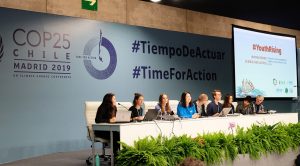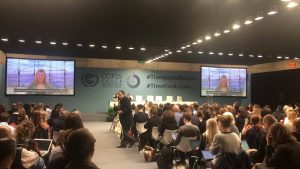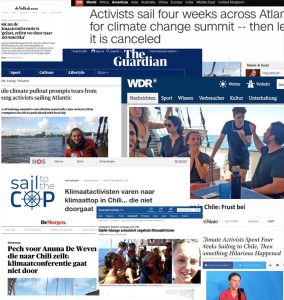After Sail to the COP – COP25 Achievements and Outlooks for 2020
In The News
20 jan 2020
Sail to the COP on board the Regina Maris sails from the ‘COP’, slowly leaving Martinique behind. The resorts and palm trees dotting the shores become smaller and smaller, and are eventually blended into the rainy horizon. The sky becomes a grey and blue water colour as rain clouds open above the sails. Rain washes away sandy footprints off the deck and the stress off the sailor’s backs. The grind and intensity of the two past weeks ‘at the COP’ melt into reflections of our actions and evaluations of our impacts. Indeed this is exactly what this article hopes to offer; a peek into the efforts and outcomes of the Sail to the COP presence at COP25.
Central contributor to the EU Youth NDC Enhancement Statement
It is difficult to enumerate the Sail to the COP’s specific impact, but the project can certainly point to several achievements during the climate summit. Firstly, Sail to the COP (henceforth: ‘SttC’) was a central contributor to the EU Youth NDC Enhancement Statement, especially strengthening aviation and transport specific demands.
Think Tank Report
 At COP26 in Glasgow 2020, countries must submit their enhanced Nationally Determined Contributions (NDCs). These will include their plans on how to meet the emission reductions necessary to keep global warming to 1.5°C. The transport sector is responsible for at least 23% of global energy-related CO2 emissions, but current targets and measures included in NDCs are far from complying with the Paris Agreement. Only 8 % of NDCs (14 countries), include a specific transport emission reduction target. Only 4 plans mention plans for the aviation sector – none of them efficient. It is clear that more ambition is needed. Based on the think tank process, and knowledge gathered at the COP, “Sail to the COP” developed the following proposals:
At COP26 in Glasgow 2020, countries must submit their enhanced Nationally Determined Contributions (NDCs). These will include their plans on how to meet the emission reductions necessary to keep global warming to 1.5°C. The transport sector is responsible for at least 23% of global energy-related CO2 emissions, but current targets and measures included in NDCs are far from complying with the Paris Agreement. Only 8 % of NDCs (14 countries), include a specific transport emission reduction target. Only 4 plans mention plans for the aviation sector – none of them efficient. It is clear that more ambition is needed. Based on the think tank process, and knowledge gathered at the COP, “Sail to the COP” developed the following proposals:
- Specific & ambitious transport emission reduction targets (inc. domestic and international aviation)
- Clear strategies for a modal shift from aviation to sustainable alternatives
- Incentives for innovation towards aircraft phase-out, as well as promotion of the development of new efficient technologies
- Investments in scientific research related to non-CO2 effects and advanced measures to address them in near-term
- Investments towards developing transformative, truly sustainable low-carbon alternative fuels
- Investments to develop and improve public transport systems and infrastructure
- Specific adaptation strategies for the transport sector
As young Europeans we additionally propose to include the following in the EU NDC:
- A kerosene tax implemented for the aviation industry with its returns allocated to sustainable transportation within Europe.
- A socially just enforcement of ticket taxes on all aviation tickets.
- A ban on state aid and an incremental withdrawal of subsidies to the aviation sector until 2030.
- A reform of the EU ETS to ensure an effective carbon price. Inclusion of all European aviation emissions within the ETS.
- A ban on all flights to destinations reachable by train within 6.5 travel hours and direct train connections between major European cities.
- An alliance on night and long-distance travel so that corridors can be approached as international ground.
- Full transparency on carbon emissions per transport mode to consumers at the point of ticket purchase.
- Enable easy booking systems for European mobility across all modes of travel, driven by a policy on timetable and ticketing data sharing across all data owners.
The inclusion of relevant stakeholders within the development process is crucial. Civil society needs to shape this process. This also includes integrating the voice of youth and the principles of climate justice to make sure that no one is left behind on our course towards reaching the goals of the Paris Agreement. You can read more specifics on each demand on the Sail to the COP NDC one-pager here.
Similarly to the NDC Youth Enhancement Statement, SttC lead the specific EU Youth Statement of Sustainable Travel and Transport. Apart from just producing statements, SttC representatives met with several country delegations; Austria, Netherlands, Belgium and Germany among them. During the bilateral with the Dutch delegation, SttC handed over their freshly printed Think Tank Report to the MEP Bas Eickhout under embargo (the report was not published yet at the COP). The report includes the description and outcomes of the Sail to the COP think tank process. The Dutch delegation has invited SttC to a meeting in the Dutch parliament in early 2020 to discuss the report outcomes and travel specific policies. You can download and read the report here.
Rail to the COP
Perhaps the most popular campaign turned out to be that of ‘Rail to the COP’. Individuals who had travelled to COP25 sustainably, or pledged to not fly to COP26 in Glasgow (of course largely only feasible for European attendees), received a ‘Rail to the COP’-pin. These pins were then observed on the collars of jackets at high level negotiations and on backpacks at youth actions. In 2020 Rail to the COP will grow into a fully-fledged campaign with the vision of bringing youth and politicians to Glasgow to cut and bring attention to travel-related emissions. The campaign will detail the specific politics required to curb travel emissions, and inform its participants accordingly. You can read more of the campaign at: www.railtothecop.com
Side events at the COP
Sail to the COP organized four of its own side-events:
1. BeNeLux Pavilion
“Collaboration governments / NGOs / companies and youth & helping/inspiring people to set up similar multi-stakeholder projects as Sail to the COP.”
2. CliMates together with Global Youth Development Institute (GYDI).
“Youth as important stakeholders in the enhancement of the NDCs”
3. German Pavilion
“Youth for European Climate Action – Distance wont stop us.”
4. ActionHub. Workshop
“Sustainable Travel Utopias”
Furthermore, the Sail to the COP ‘Dear World Leaders’ video was shown multiple times throughout the COP, for example at the Chilean and the Belgian pavilions, and the #YouthRising side-events with over 300 participants. SttC representatives additionally spoke at 3 other side-events (e.g. with Fridays for the Future, Transport & Environment, and the IASS), and asked critical questions at over 40 other events. These questions, carefully formed by the dynamism between the Ship and the Ground team, lead to several follow up conversations (e.g. at SloCaT events and in the citizen dialogue with Frans Timmermans).

SttC was the biggest youth group attending COP26, and were commended multiple times on their activity, presence and expertise. Organised parallel to the COP, the Social Summit in Madrid was a highly important event, underlining the ambition and organisation of civil society. SttC organised a side-event at the Social Summit together with Stay Grounded, an umbrella organisation for no-fly movements. The event inspired many participants to remain at the venue for discussion well after the intended end time. Additionally to the side-event, SttC organised a photo exhibition of the two-month sea voyage, and main findings at the Social Summit. The same exhibition was also organised at the German pavilion inside the official COP venue, IFEMA.
Intense and active social media presence
Apart from the very physical efforts at the COP, SttC also had a significant, intense and active social media presence during the two weeks. Facebook, Twitter and Instagram were all utilised to their full capacity. Among other highlights;
- the SttC Facebook followship enjoyed a live stream of the #YouthRising event and the post “Why didn’t we fly back” – bringing attention to the lack of tax on plane tickets.
- The Twitter warriors were actively posting and reactively retweeting and commenting through the entire day from 3am to 3pm (8am to 8pm CET). Questioning ICAO’s (International Civil Aviation Organisation) #FlyDay campaign and their framing of aviation’s “climate action” received widespread attention. Similarly, bringing to question the plane-sized holed in the freshly released European Green Deal, tagging Frans Timmermans and Ursula von Leyen, peaked the interest of the Twittersphere.
- The SttC Instagram account put out amazing material around the clock as well. Among others, the “Good COP / Bad COP”- series received praise; highlighting the unsustainable versus sustainable practises of the COP organisers in Madrid. For example, attention was called to the food arrangements, with Burger King being the first food business greeting participants arriving at the COP venue. Instagram also exhibited the intimate behind-the-scenes life and the everyday experiences of the Ship and Ground teams.
Looking ahead for more impact
The soft effects of the sizable youth presence, and highlighting travel as a sector of particular concern, are of course near impossible to quantify in terms of CO2 equivalents. However, the gradual impacts may indeed produce the greatest effect, contributing to a larger undercurrent; establishing discourse and shifting public opinion through sheer exposure. Sail to the COP looks firmly ahead to the year 2020, the UNFCCC intersessionals and COP26. Rail to the COP and Sail for Climate Action will serve as the SttC flagship projects, but other projects emerging from the think tank process, unrelated to international climate politics are being developed further as well. The 2019 iteration of SttC might be coming to a close, but the future only promises galvanised determination as the climate movement grows in its numbers and in its necessity.
Sail to the COP imagines a world in which travel demand is reduced and travelling is always meaningful. A reality in which all relevant actors cooperate and take bold action, fostering a fair and sustainable travel industry. A future in which travel is a force for good and does no harm to the travellers themselves, the communities that welcome them and the environment.
Author: Santeri Lehtonen


 At COP26 in Glasgow 2020, countries must submit their enhanced Nationally Determined Contributions (NDCs). These will include their plans on how to meet the emission reductions necessary to keep global warming to 1.5°C. The transport sector is responsible for at least 23% of global energy-related CO2 emissions, but current targets and measures included in NDCs are far from complying with the Paris Agreement. Only 8 % of NDCs (14 countries), include a specific transport emission reduction target. Only 4 plans mention plans for the aviation sector – none of them efficient. It is clear that more ambition is needed. Based on the think tank process, and knowledge gathered at the COP, “Sail to the COP” developed the following proposals:
At COP26 in Glasgow 2020, countries must submit their enhanced Nationally Determined Contributions (NDCs). These will include their plans on how to meet the emission reductions necessary to keep global warming to 1.5°C. The transport sector is responsible for at least 23% of global energy-related CO2 emissions, but current targets and measures included in NDCs are far from complying with the Paris Agreement. Only 8 % of NDCs (14 countries), include a specific transport emission reduction target. Only 4 plans mention plans for the aviation sector – none of them efficient. It is clear that more ambition is needed. Based on the think tank process, and knowledge gathered at the COP, “Sail to the COP” developed the following proposals:
